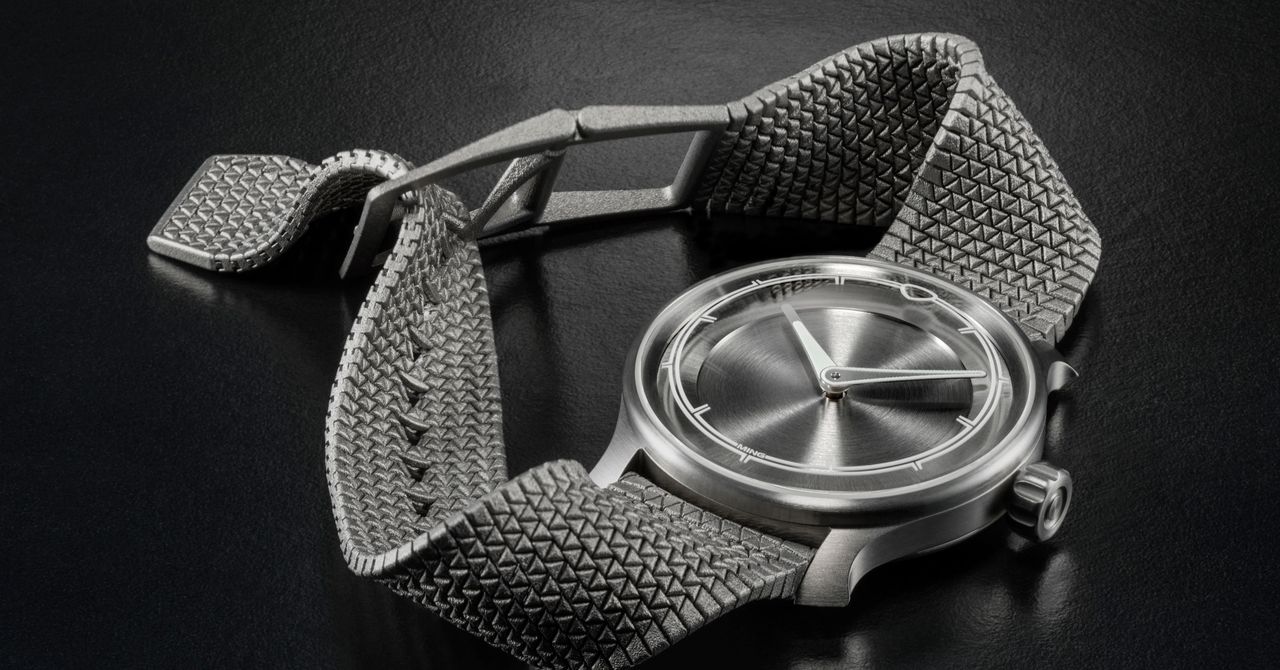Tech
This Watch Brand Has Made a Completely New Kind of Strap Using Lasers

Want a watch strap that’s as comfortable as fabric, as light as rubber, as strong as a metal bracelet and as tactile as a Milanese mesh?
Any watch fan looking to tick all of the above boxes would normally expect to be a dab hand with a spring bar removal tool to experience all the above individually, but a new strap developed by Malaysian independent brand Ming appears to now offer the best of all worlds.
Photograph: Courtesy of Ming
The one strap to rule them all has been dubbed the Polymesh, and is 3D-printed from grade five titanium, and comprises 1,693 interconnected pieces (including the buckle) held together without any pins or screws. The only additional parts requiring assembly are the quick-release spring bars at each end that attach it to the watch—the articulated pin buckle is also formed in the same process.
Ming says that the strap, which is made up from rows of 15 equilateral triangles, meshed together and bookended by larger end pieces, “has more motion engineered into the radial axis than the lateral one,” leading to a supple end result that drapes like fabric yet retains the strength of titanium.
It has taken the company seven years to develop, working with partners Sisma S.p.A in Italy and ProMotion SA in Switzerland. Ming says notable challenges included the risk of components fusing together, and the fact that powdered titanium—the raw material from which the strap is laser sintered—is highly explosive. The straps each take several hours to produce, requiring hundreds of layers of additive manufacturing in an inert gas environment.
The company is not the first to use 3D-printing techniques for final products in watchmaking (as opposed to prototyping), but it is the only one using it for straps or bracelets. British start-up Apiar has debuted a 3D-printed watch case, as has Dutch brand Holthinrichs, which has created versions of its Ornament 1 in both 18k gold as well as stainless steel.
The Case for Straps
To the extent that straps have been an area for innovation in the watch world, recent attention has tended to focus on brands’ development of proprietary mechanisms for swappable straps, to varying degrees of success and popularity. Sustainability programmes that focus on leather alternatives such as reclaimed apple peel or mushroom-based material, or textiles woven from ocean plastic. Some have proven difficult to industrialize, and nearly all have been dogged by accusations of greenwashing.
Tech
The Best Cyber Monday Streaming Deals With a Convenient Roommate’s Email Address

HBO knows you’re bored and cold. It wants you to Max and chill with Noah Wyle in scrubs. The company offers some of the best Cyber Monday streaming deals with a ridiculously low-priced $3/month offer for basic HBO Max (it’s the version with ads and 2K streaming, but still, super-cheap). Disney Plus and Hulu deals are bundled up for $5/month. Apple TV wants back in your life for $6.
Of course, this deal is only meant for new customers. Not boring ol’ existing customers. If you already have basic HBO Max, you’re already paying $11 for the same service, and HBO would like you to keep doing that. Streaming apps are banking on you being complacent and happy in your streaming life. Maybe they’re even taking you for granted.
Sometimes you can get the current deal just by threatening to cancel, or actually canceling, your account. Suddenly, you’re an exciting new customer again! Another method is by using an alternate email account (perhaps your spouse’s or roommate’s?) and alternate payment information as a new customer. If you do use a burner email (you did not hear this from me), check in on your favorite app’s terms of service to make sure you’re not in violation by re-enrolling with different emails. I’ll also issue the caveat that you lose all your viewing data and tailored suggestions if you sign up anew.
But times and wallets are tight! And $3 HBO Max sounds pretty good. After all, every middle-aged American man needs to rewatch The Wire once every five years or so—assuming he’s not the kind of middle-aged man who rewatches The Sopranos instead. Here are the current best streaming deals for Cyber Monday 2025.
Devon Maloney; ARCHIVE ID: 546772
Regular price: $80
Tech
SAP user group chair warns of AI low-hanging fruit risks | Computer Weekly

The UK and Ireland SAP User Group (UKISUG) Connect 25 conference has opened in Birmingham with a keynote session recognising the challenges business face.
The user group itself has adapted to changes in the technology market such as the advent of artificial intelligence (AI) in business applications and the economic climate that has a profound effect on its members’ ability to deliver value with enterprise technology.
In his keynote presentation, Conor Riordan, chair of UKISUG, said: “As an organisation, we have to change, to position ourselves as we move from the old to the new.”
The user group has a 2030 plan, recognising the shifts in enterprise software. For instance, there is the shift to no-code and low-code tooling, which has implications on the agility of enterprise software development. Riordan noted that the current business climate and geopolitical volatility means that there is a huge pressure to reduce costs, leading to cuts in training budgets and the challenge of delivering more with less, adding: “We need to have process change.”
Moving to a future where organisations are using data to make more dependable decisions, Riordan noted that SAP is moving to a dynamic ecosystem of applications and AI, but the challenge is how quickly businesses can start taking advantage of the AI now available in their business applications. “We see members say SAP AI will help them,” Riordan said.
But many are concerned how the new technology now available will deliver a return on investment (ROI). For Riordan, IT decision-makers need to be wary of tackling the so-called low-hanging fruit, the use cases that the industry sells to the executive team: “It is really complex work, and the low-hanging fruit is not that low hanging. It will take years, not months, to deliver value.”
A poll of delegates at the conference found that 78% of respondents are just getting started with AI, while 29% say their AI initiatives have under-delivered.
“This stuff is not easy,” Riordan said, adding that the challenge is one of process re-engineering and culture change, and that he believes humans need to be at the centre of decision-making. “We ask partners to be reasonable in their productivity claims so we can all succeed together.”
The Value of AI in the UK: Growth, people & data from SAP and Oxford Economics, which was published in October 2025, notes that customers are investing £16m in AI on average this year. The report’s authors predict this will increase by 40% within the next two years. However, the theme coming out of the keynote session at Connect25 is that few companies are really using AI.
Another big topic covered during the keynote is the end of support for SAP products. With SAP’s 2027 maintenance deadline for SAP ECC 6.0 fast approaching, many organisations are now embarking on their migration journey to SAP S/4Hana. More than half (54%) of respondents said that gaining access to SAP’s AI offerings will influence their future deployment of SAP.
Among attendees of Connect25, 49% said they are working towards the 2027 deadline. Riordan called on SAP to help customers to move to the cloud and build a tangible business case.
During her keynote speech, Leila Romane, managing director of SAP UK & Ireland, spoke about the AI opportunity, saying: “We are helping customers unleash new value with business AI.”
SAP’s strategy is to drive business value through the power of AI, data and its enterprise applications, with the SAP Cloud integral in SAP’s strategy to deliver AI-enablement across its enterprise software suite. Romane said SAP recognised that its customers were all at different stages of their cloud journey, adding: “Our commitment is to help you move.”
Tech
Hong Kong FWA services market set for 9.6% growth | Computer Weekly

Analysis from GlobalData is forecasting that fixed wireless access (FWA) service revenue in Hong Kong is expected to increase at a “healthy” compound annual growth rate (CAGR) of 9.6% between 2025 and 2030.
The latest Hong Kong Total Fixed Communications Forecast set out to quantify current and future demand and spending on mobile services for the special administrative region of China. It noted that growth was being driven by Hong Kong’s extensive 5G network coverage and could also be attributed to local operators’ efforts to expand FWA services and position it as an alternative to traditional fibre broadband services for both residential and commercial sectors, meeting growing demand for high-speed connectivity in areas where extending fibre lines is challenging.
“High-density urban and suburban centres of Hong Kong create a strong business case for FWA services due to their cost-effective and rapid deployments without the complex infrastructure and civil work required for extending fibre-optic lines to such locations,” said Neha Misra, senior analyst at GlobalData.
“Competitive, feature-rich plans from the operators will also help drive its adoption over the forecast period. For instance, HKBN’s 5G Home Broadband Plan provides unlimited 5G broadband data (subject to a 300GB with a fair-usage policy) for HKD118 per month on a 24-month contract, along with a seven-day trial guarantee. The plan also includes a waiver of the HKD28 monthly administration fee and complimentary access to the basic HomeShield security plan.”
In addition to HKBN, the study noted that operators such as 3 Hong Kong and HKT are also using their extensive 5G networks to offer home broadband services, particularly in areas with limited fibre infrastructure. It cited HKT as recently having successfully deployed mmWave-based FWA to deliver ultra-high-speed internet to rural areas and outlying islands.
“Growing demand for FWA provides operators a strong revenue opportunity by expanding home and SME broadband without the high capital intensity of fibre roll-out,” Misra added. “By leveraging nationwide 5G coverage, introducing competitively priced service plans and bundling digital home services, operators can unlock higher ARPU [average revenue per user], accelerate market penetration in underserved areas and diversify beyond traditional revenues.”
GlobalData believes the Hong Kong government’s smart city initiatives will also open new opportunities for FWA, especially 5G FWA, which can deliver high-speed internet to power applications such as the digital economy, digital governance and e-health services, while supporting the city’s dense urban environment and digital transformation goals under the Smart City Blueprint 2.0.
The original blueprint was set out in December 2017, outlining 76 initiatives under six smart areas, namely Smart Mobility, Smart Living, Smart Environment, Smart People, Smart Government and Smart Economy. Blueprint 2.0 puts forth more than 130 initiatives that continue to enhance and expand existing city management measures and services. The new initiatives aim to bring benefits and convenience to the public so that residents can better perceive the benefits of smart city innovation and technology.
-

 Sports1 week ago
Sports1 week agoWATCH: Ronaldo scores spectacular bicycle kick
-

 Entertainment1 week ago
Entertainment1 week agoWelcome to Derry’ episode 5 delivers shocking twist
-

 Politics1 week ago
Politics1 week agoWashington and Kyiv Stress Any Peace Deal Must Fully Respect Ukraine’s Sovereignty
-

 Business1 week ago
Business1 week agoKey economic data and trends that will shape Rachel Reeves’ Budget
-

 Politics1 week ago
Politics1 week ago53,000 Sikhs vote in Ottawa Khalistan Referendum amid Carney-Modi trade talks scrutiny
-

 Tech6 days ago
Tech6 days agoWake Up—the Best Black Friday Mattress Sales Are Here
-

 Fashion1 week ago
Fashion1 week agoCanada’s Lululemon unveils team Canada kit for Milano Cortina 2026
-

 Tech1 day ago
Tech1 day agoGet Your Steps In From Your Home Office With This Walking Pad—On Sale This Week



















